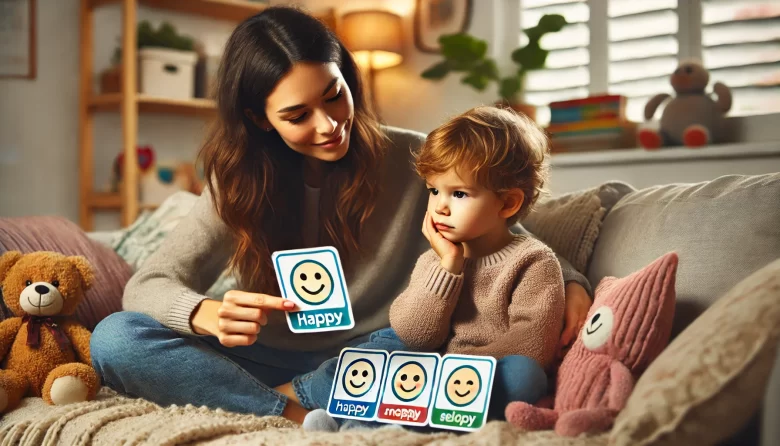Emotional intelligence (EQ) is just as important as academic skills in a child’s development. It helps children understand their emotions, empathize with others, and manage challenges effectively. Teaching emotional intelligence at home equips kids with essential life skills, improving their relationships, problem-solving abilities, and overall well-being.
In this article, we will explore what emotional intelligence is, why it matters, and practical ways to nurture it in children.
What Is Emotional Intelligence?
Emotional intelligence refers to the ability to:
- Recognize and understand one’s own emotions
- Manage emotions effectively
- Recognize and respond to the emotions of others
- Develop healthy relationships and social skills
Children with strong emotional intelligence tend to be more resilient, adaptable, and successful in both school and personal life.
Why Is Emotional Intelligence Important for Children?
Teaching children to understand and manage their emotions has lifelong benefits, including:
- Better problem-solving skills – Helps children stay calm and think through challenges.
- Stronger relationships – Builds empathy and cooperation with peers.
- Higher self-confidence – Encourages self-awareness and positive self-talk.
- Reduced anxiety and stress – Helps children regulate their emotions and cope with difficulties.
Developing emotional intelligence from an early age helps children navigate social situations, express themselves effectively, and build healthy relationships.
Ways to Teach Emotional Intelligence at Home
Help Children Identify Their Emotions
Children need to recognize their feelings before they can manage them. Encourage them to name their emotions by using words like:
- “I see you’re feeling frustrated because your toy broke.”
- “You look really happy after playing with your friend!”
Using books, flashcards, or emotion charts can help young children associate words with feelings.
Teach Healthy Ways to Express Emotions
Let your child know that all emotions are valid, but how they express them matters. Teach them:
- To talk about feelings instead of yelling or acting out
- To take deep breaths or count to ten when feeling overwhelmed
- To draw or write about their emotions in a journal
Encouraging open conversations about feelings helps children feel comfortable expressing themselves.
Be a Role Model for Emotional Intelligence
Children learn by observing adults. Show them how to manage emotions in a healthy way:
- Instead of saying, “I’m so angry!” say, “I feel frustrated, so I’m going to take a deep breath.”
- Apologize when needed: “I’m sorry for raising my voice. I should have spoken calmly.”
- Express gratitude and empathy in daily interactions.
Encourage Problem-Solving and Decision-Making
Instead of solving problems for your child, guide them through thinking of solutions:
- “What could you do if your friend doesn’t want to share?”
- “How can we make sure both of us feel happy?”
This helps them develop independence and confidence in handling conflicts.
Use Storytelling and Role-Playing
Stories and role-playing games help children understand emotions in different situations. You can:
- Read books about emotions and ask, “How do you think the character feels?”
- Pretend-play scenarios like making a friend feel better or handling a disagreement.
This interactive approach makes learning about emotions fun and engaging.
Encourage Empathy and Understanding of Others
Teaching children to recognize and care about others’ feelings strengthens their emotional intelligence. Try:
- Discussing how others might feel in different situations.
- Encouraging acts of kindness, like helping a friend or making a thank-you card.
- Asking questions like, “How would you feel if that happened to you?”
Create a Safe Space for Emotional Expression
A child needs to feel safe expressing emotions without fear of judgment. Support them by:
- Listening attentively when they talk about their feelings.
- Validating their emotions with phrases like, “It’s okay to feel sad sometimes.”
- Encouraging open discussions about fears, worries, and joys.
Activities to Boost Emotional Intelligence
Here are some fun and simple activities to help your child practice emotional skills:
Emotion Faces Game
Make different facial expressions and ask your child to guess the emotion. You can also use emotion flashcards for a visual learning experience.
Feeling Check-Ins
Have daily check-ins where everyone in the family shares how they are feeling and why. This normalizes talking about emotions.
The “What Would You Do?” Game
Present different scenarios and ask your child how they would react. For example:
- “What would you do if your friend was crying?”
- “How can you help if someone feels left out?”
This helps children think about emotional responses in real-life situations.
Mindfulness and Breathing Exercises
Teach simple breathing exercises to help your child calm down during stressful moments. Try:
- “Smell the flower, blow out the candle” (inhale through the nose, exhale through the mouth).
- Guided mindfulness activities using apps or YouTube videos for kids.
Gratitude Practice
Encourage children to list things they are grateful for. This can be done:
- Through a gratitude journal
- By saying three good things before bedtime
- By creating a “gratitude jar” where they add notes about positive experiences
Practicing gratitude helps children focus on positive emotions and develop resilience.
When to Seek Additional Support
While most children develop emotional intelligence through daily interactions, some may struggle with managing emotions. Consider professional support if your child:
- Has frequent emotional outbursts that disrupt daily life.
- Struggles to recognize or express emotions.
- Shows signs of anxiety, extreme shyness, or difficulty forming relationships.
A child psychologist or counselor can provide guidance and strategies to support emotional development.
Final Thoughts
Teaching emotional intelligence at home sets the foundation for a child’s long-term success and happiness. By helping children identify emotions, express themselves healthily, and build empathy, you equip them with valuable life skills.
By modeling positive behaviors, encouraging open discussions, and engaging in emotional intelligence activities, you create a nurturing environment where children can grow emotionally strong and confident.
With patience and consistency, your child will develop the emotional skills they need to navigate life’s challenges with resilience and kindness.




